The pace of change in Flushing, Queens has accelerated in the past 30 years, as its Victorian-age buildings have mostly been razed. But concentrated at Kissena Blvd. and Sanford Ave. are a number of amazing buildings constructed decades ago and in one case, over a century and a half ago.
Flushing is no longer thought of as heavily Jewish—immigrants from Asia have shaped the area the last 20 to 30 years—so it’s surprising to find this imposing, Corinthian-columned edifice, the Free Synagogue of Flushing, at Kissena Blvd. and Sanford Ave.
The temple was founded in 1917 by the Hebrew Women’s Aid Society and was named the Free Synagogue because it followed the principles of the first “free” synagogue, the Stephen Wise Free Synagogue in Manhattan. The principles included freedom of religious philosophy, seating positions (some synagogues separate men and women), equality of men and women in participation and leadership, and a general liberal philosophy in all matters.

According to the Free Synagogue, the windows depict Noah’s Ark, the lions of Judah (in the time period of the Old Testament, lions could be found in Palestine), great swirls of leaves and vines and delicate flowers symbolizing Sukkot, and the two hands of the priestly blessing, which many know as Spock’s “Live Long and Prosper” symbol from Star Trek. In the center of the domed ceiling that covers the entire sanctuary is a smaller stained-glass dome designed around a Star of David.
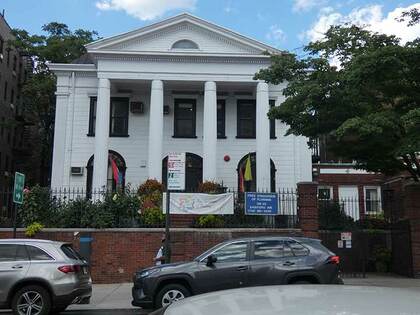
Next door on Sanford Ave. is the building where the synagogue’s services were originally held, the Lindley Murray Hoffman Mansion. Originally constructed around 1845, when much of Flushing was still farms and fields, this is one of the last freestanding mansion buildings in Flushing. After several years as the Windsor School, it’s once again owned by the synagogue.

As post office architecture goes, Colonial Revival is a popular style—Flushing’s majestic post office building, Main St. and Sanford Ave., with its pediment and six Ionic columns, is similar to post offices in Hunters Point and also in St. George, Staten Island. It was constructed from 1932-1934 and designed by Dwight James Baum and partner William W. Knowles; most of Baum’s other NYC buildings are in Riverdale, Bronx, including the neighborhood’s iconic bell tower at Riverdale Ave. and Henry Hudson Parkway. I was by on a weekday and decided to have a look around. The lobby must look similar to when the building opened in 1934, with hanging lamps, marble walls and gilt-edged service windows.
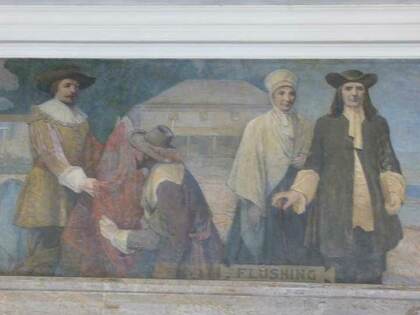
The main attraction in Flushing, P.O., though, are the wall murals created by Vincent Aderente (1880-1941), an immigrant (at age six) from Naples, Italy, who studied at the Art Students League and became an assistant to muralist Edwin Blashfield. His commissions beside the Flushing P.O. are found in Brooklyn’s Kings County Hospital, Queens County Court House, Denver Mint, Detroit Public Library, and until it was demolished, the Long Island Savings Bank; after the mural was stolen, the bank was demolished, but a copy turned up and could be seen in the Quinn Funeral Home on Broadway and 36th St. in LIC until its closure in 2018. The mural’s currently in the possession of the Greater Astoria Historical Society.
The murals are arranged on the upper walls of the P.O. above the service windows, boxes, etc. and depict Queens neighborhoods surrounding Flushing on the east and west. Some murals, such as Flushing’s, show extant historic buildings, such as the Quaker Meeting House which still stands on Northern Blvd. and Linden Pl. The mural shows Dutch traders and a man (possibly John Bowne, a Britisher who originated the concept of religious freedom in 1620s Flushing) and his wife.
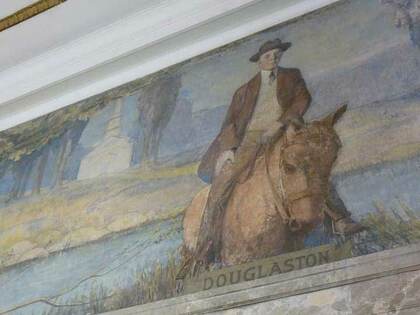
Douglaston’s mural shows the Zion Episcopal Church, constructed in 1830 on Northern Blvd. and rebuilt in an almost exact replica after a fire in the 1920s. The man on horseback, possibly George Douglas, the original property owner, is riding past Little Neck Bay or Alley Creek.
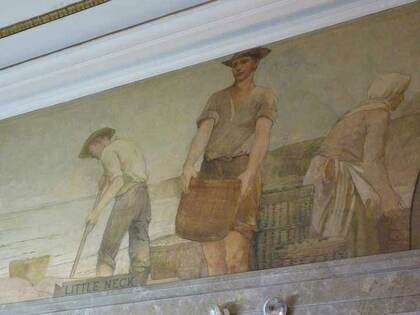
In the 19th century Little Neck Bay was famed for its huge stores of oysters and clams, which were considered New York City’s favored fast food. Pollution eliminated the oyster harvest in the early-20th century. Other murals depict colonial-era scenes in Bayside, College Point, Elmhurst, Corona, Forest Hills, Jackson Heights and Maspeth, all areas in northern Queens.
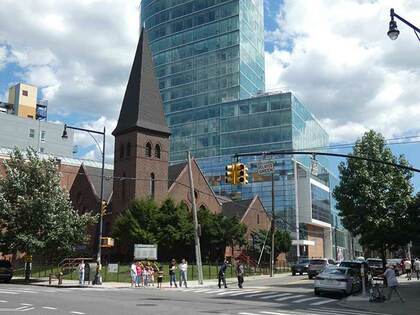
The First Baptist Church, Sanford Ave. and Union St., isn’t really the “first” First Baptist; the original was on Union St. south of Northern Blvd. When the present structure was built in 1890 the original church, located in the “V” formed by Main St. and Kissena Blvd., served a stint as the town library. It now sits behind a giant glassy mixed-use tower, which dwarfs it.
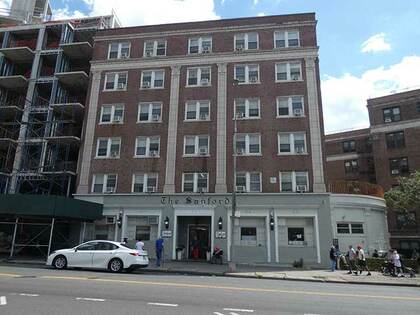
Nathan Sanford of Flushing was a major figure in New York politics, serving as a U.S. attorney, state assemblyman, state senator and eventually a U.S. senator. He built a grand mansion at the present Kissena Blvd., then called Jamaica Rd., in 1836; but didn’t have much time to savor it, as he died in 1838. The mansion and grounds were acquired by the MacDonald family and Dr. James McDonald converted it to a mental institution for the wealthy called Sanford Hall. The institution closed in 1910 and parcels were sold off.
The Sanford, which sits on the institution’s old acreage on Sanford Ave., is a successor of sorts. It opened in the 1920s and was never a luxury hotel, but did host lavish wedding receptions in its heyday in the 1930s and 1940s. It’s currently the Sanford Home for Adults, a treatment facility for older individuals suffering from mental health or substance abuse issues.
—Kevin Walsh is the webmaster of the award-winning website Forgotten NY, and the author of the books Forgotten New York (HarperCollins, 2006) and also, with the Greater Astoria Historical Society, Forgotten Queens (Arcadia, 2013)

